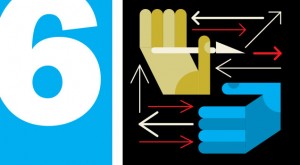 NUMBER SIX: BETTER TRAINING FOR NOVICE SURGEONS
NUMBER SIX: BETTER TRAINING FOR NOVICE SURGEONS
It’s a century-old rite of passage for novice surgeons: being raked over the coals by an attending physician with thousands of hours more experience in dissecting, suturing, and manipulating tissues. But soon that traditional friendly (or not-so-friendly) instruction might be augmented by a much more dispassionate kind of guidance: computer systems that quantitatively analyze novice surgeons’ hand movements and tell them exactly how and where they can improve.
That is the vision of a team of Johns Hopkins engineers and surgeons led by Gregory Hager, Mandell Bellmore Professor and past chair of Computer Science. By analyzing tool movements in hundreds of surgeries, Hager’s team has identified movement “signatures” that are characteristic of novice and expert surgeons.
“What we aim to do,” Hager says, “is to break complex tasks down into small units so we can provide surgeons-in-training with feedback on which parts of a particular task they’re not doing well on.”
The team is already piloting such an approach at the Johns Hopkins Minimally Invasive Surgical Training and Innovation Center, with support from the National Science Foundation and the Johns Hopkins Science of Learning Institute. Among other things, the project, which focuses on robotic surgery, will follow individual surgeons throughout their training, noting the pace at which their characteristic hand movements make the transition from novice to expert. One focus of Hager’s efforts is septoplasty, a nasal surgery commonly performed to correct a deviated septum. In collaboration with Lisa Ishii MS ’09 (BSPH) and Masaru Ishii, associate professors of otolayrngology at the School of Medicine, Hager’s team is testing new methods of training novices to perform the procedure.
“Septoplasty is traditionally very difficult to teach,” Hager says, “because it’s hard to show a trainee exactly what an expert is doing deep in the nose.”
By attaching tiny motion sensors to surgical instruments in septoplasty, Hager and his colleagues have been able to provide new kinds of feedback to novice surgeons.
“Somewhat accidentally,” Hager says, “we set up a computer screen showing the instrument tracking, just so we could see what was going on. That in itself was already an innovation—the attendings and the trainees could now see on a screen how the tool was moving inside the nose. Now they can say, for example, ‘Your strokes are too short and tentative; you should move further under the skin flap here and make longer strokes.’”
Computers will never replace human instruction, of course. As Hager notes, surgical skill involves far more than hand movements. Nonetheless, he believes that data-driven improvements in technical-skill measurement could profoundly transform the practice of surgery.
“We’re really just at the beginning of the age of studying surgery as a data science,” he says. “Could we start to quantify interventional procedures in such a way that we can advance practice and improve patient outcomes? Can we develop scorecards that can follow surgeons throughout their careers and help them to maintain and improve their skills?” “We couldn’t do any of this without having the School of Medicine completely on board,” says Hager. “This kind of sustained teamwork sets the stage for new discoveries.”




